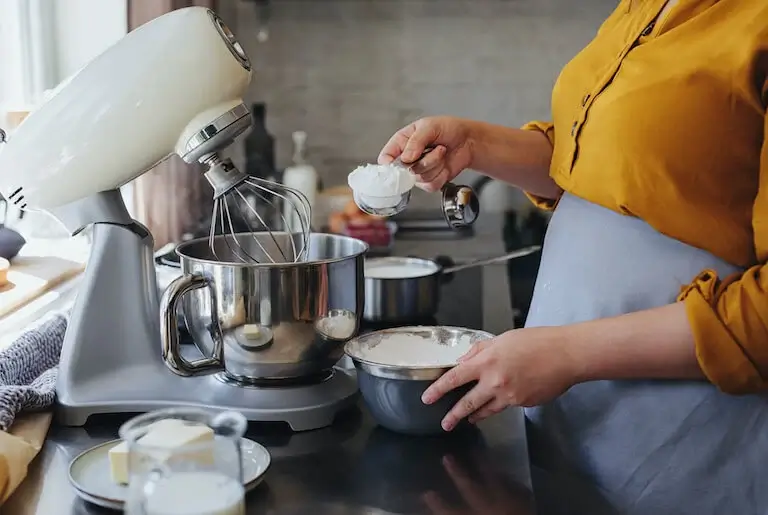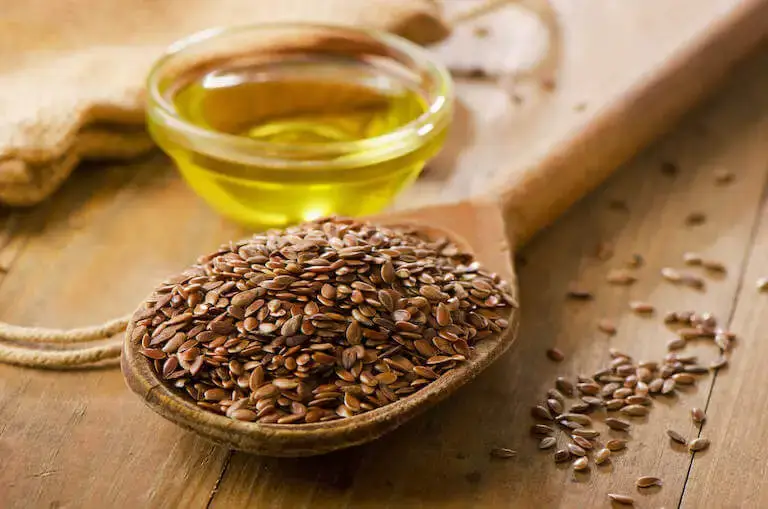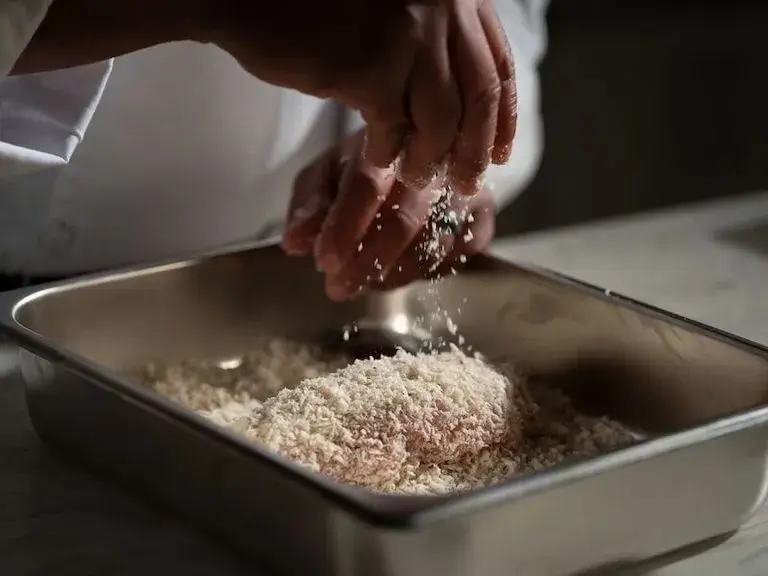Listen to This Article:
Whether you’re in the middle of baking and realize you’re out of eggs, cooking for someone with an allergy, or following a vegan diet, chances are you’ve wondered: What can I substitute for eggs? The good news is, you’ve got options—plenty of them. Some swaps are great for binding and structure, while others add moisture or help your baked goods rise.
In this guide, we’ll break down the best egg substitutes for baking and cooking, including specific recommendations for cookies, brownies, pancakes, cake mix, and even savory dishes like meatloaf. And because knowing why eggs matter is half the battle, we’ll also explain what eggs actually do in your recipes so you can choose the right substitute every time.
Why Are Eggs Important in Baking and Cooking?
Before you start swapping, it helps to understand what eggs are actually doing in a particular recipe. When you know this, you can match the right substitute to the job.
In baking, eggs provide structure, moisture, lift, and they emulsify, or bring together, ingredients. In practice, they help cakes rise, hold cookies together, and give brownies their signature fudgy texture we all know and love. And if you’ve ever wondered why cake batter is so smooth, you can thank lecithin, a compound in egg yolks that helps fat and water mix nicely.
In cooking, it’s a little less complicated. Eggs act as a binder (like in meatloaf or veggie burgers, or latkes and hash browns) or as a coating, like when making breaded chicken. Of course, they can be the main ingredient too, like scrambled eggs or a quiche.

Knowing how eggs (or their substitutes) function in a recipe is key to baking success.
Best Egg Substitutes for Baking
When baking, the right egg substitute depends on what you’re making. If you take a moment to reverse-engineer your recipe, you’ll end up with better results.
For example, if you glance at a cake recipe that doesn’t have leaveners like baking soda or baking powder, you can be pretty sure that the eggs are doing the heavy lifting. If a recipe doesn’t have a lot of liquid, the eggs are adding moisture.
Another thing to keep in mind: Egg-heavy recipes (4 or more eggs) may not turn out the same with substitutes. If you want to avoid eggs in your recipes purely based on rising costs, ditch cakes like chiffon, angel food cake, or Genoise which depend almost entirely on eggs for structure and lift.
On the other hand, chocolate cake recipes, coffee cakes, and Wacky cakes (an egg-free, oil-based chocolate cake from the Depression era), rely on little to no eggs, getting their moisture and lift from oils and baking soda/powder.
When choosing a substitute for eggs, ask yourself:
- Do I need structure and stability?
- Do I need moisture?
- Do I need leavening (something to help it rise)?
- Do I need binding power?
Chia Seeds (AKA Chia Egg)
Best for: Recipes where structure and moisture matter but you don’t need much lift, like cookies, pancakes, muffins, and quick breads.
Chia seeds are one of the most popular plant-based egg swaps, especially in vegan baking. You’ll often hear it called a chia egg—made by mixing 1 tablespoon of chia seeds with 3 tablespoons of water. Let the mixture sit for 5 to 10 minutes until it thickens into a gel. That’s your egg replacement, roughly equal to one egg.
A nice bonus? Chia seeds are loaded with omega-3 fatty acids, fiber, and protein, so they sneak a little nutritional boost into your baked goods without changing the flavor. Just a heads up—they can add a slight crunch and a speckled look to your batter.
Flax Seeds (AKA Flax Egg)
Best for: Recipes where structure and binding matter more than lift—like brownies, quick breads, cake mixes, and even pancakes.
Next up: the flax egg, another tried-and-true plant-based egg swap. Like the chia egg, it’s made by mixing 1 tablespoon of ground flaxseed with 3 tablespoons of water and letting the mixture sit for 5 to 10 minutes until it thickens into a gel.
If you’ve had flax before, you know it has a slightly nutty flavor. That taste can peek through in lighter recipes—just something to keep in mind—but it’s not necessarily a bad thing. It can actually add a nice, earthy note depending on what you’re baking.

Flax seeds are a go-to egg substitute in baking, adding binding power and a subtle nutty flavor.
Applesauce
Best for: Soft, tender bakes like banana bread, spice cake, snack cakes, muffins, and cupcakes. Basically, anything cozy and moist you might think to bake on a rainy day.
Applesauce is one of the easiest and most popular egg substitutes, especially if you’re baking something soft and sweet. To replace one egg, use ¼ cup of unsweetened applesauce and simply add it in whenever the recipe calls for the egg(s). No extra prep needed.
Because applesauce is naturally sweet and full of moisture, it works best in baked goods where a little extra softness is welcome. Just keep in mind—it can make the texture a bit denser, so it’s not ideal for recipes that need a lot of lift (think chiffon cakes or angel food cakes).
Mashed Banana
Best for: Recipes where a hint of banana flavor works—like banana bread (obviously), chocolate cake, brownies, pancakes, and muffins.
Got an overripe banana sitting on the counter? Turn it into an egg substitute. Just like the applesauce trick, you’ll use ¼ cup of mashed ripe banana to replace one egg. Simply mix it in whenever the recipe calls for the egg(s).
Banana adds plenty of moisture and binding power, which is perfect for baked goods like brownies, muffins, and quick breads. Just a heads up—it also brings its own distinct flavor. So if you’re not a banana fan, you might want to skip this one. That said, it pairs beautifully with warm spices, chocolate, and anything in the breakfast-y baked goods category.
Another bonus? It adds natural sweetness, so you can often dial back the sugar a bit if you’re looking to lighten things up.
Yogurt or Buttermilk
Best for: Cakes, muffins, pancakes, quick breads—basically, soft and tender baked goods that benefit from a bit of extra moisture.
If your recipe uses eggs mainly for moisture, yogurt or buttermilk is an easy swap. Both add moisture and help bind ingredients together without changing the flavor too much—a win-win.
To replace one egg, use ¼ cup of plain yogurt or buttermilk and mix it in whenever the recipe calls for the egg(s). If you’re using yogurt, stick to plain, unsweetened varieties. Greek yogurt works too, just thin it out with a splash of milk if it’s extra thick.
These swaps are best in bakes where a little extra richness and tang won’t hurt. They won’t provide much lift, so don’t count on them for recipes that rely heavily on eggs for structure (like a sponge cake).
Can I Use Mayonnaise as an Egg Substitute?
Absolutely. If you’re out of the pantry items on this list (and don’t need the recipe to be egg-free), head to your condiment shelf. Since mayo is made from eggs and oil, it adds moisture and fat—just like an egg would. Use 3 tablespoons of mayo per egg. It won’t help with leavening, so it’s best for recipes that already include baking powder or soda.
Vinegar + Baking Soda
Best for: Recipes that need rise and airiness—like cakes, cupcakes, quick breads, and fluffy pancakes.
Making a baked good that needs a little lift? Vinegar and baking soda is likely your best bet. When you mix these two ingredients, they create a chemical reaction that releases carbon dioxide, which helps your baked goods rise and stay light and fluffy.
To replace one egg, mix 1 tablespoon vinegar (white or apple cider vinegar works best) with 1 teaspoon baking soda. Add the mixture to your batter right when the recipe calls for the egg(s).
Since this swap is all about adding lift, use it in recipes where eggs act as a leavener—not necessarily when you need binding.
Commercial Egg Replacers
A final option is a commercial egg replacer, which you can usually pick up at your local grocery store, speciality store, or online. These blends are typically made from a mix of potato starch, tapioca flour, and leavening agents designed to mimic the binding and lifting power of eggs—without the egg. Some are also gluten-free for those with gluten sensitivities.
Most will have a simple ratio on the back for how to make a mixture equivalent to one egg.
Quick Reference: Egg Substitutes for Baking
Use this chart to find the best egg substitute for baking based on what you’re making. Each swap is chosen to mimic what eggs are doing in that particular recipe—whether that’s moisture, structure, or lift.
| Recipe | What Eggs Do in Recipe | Best Substitute |
|---|---|---|
| Cookies | Binding, a little moisture | Flax egg, chia egg, commercial egg substitute for cookies |
| Brownies | Moisture, fudgy texture | Applesauce, mashed banana, flax egg – great egg substitute for brownies |
| Cake Mix | Moisture, structure | Applesauce, yogurt, commercial replacer – ideal egg substitute for cake mix |
| Pancakes | Leavening, moisture | Vinegar + baking soda, chia egg – easy egg substitute for pancakes |
| Quick Breads/Muffins | Moisture, binding | Banana, applesauce, flax egg |
| Snack Cakes | Moisture, a bit of rise | Vinegar + baking soda, applesauce, yogurt |
Best Egg Substitutes for Cooking
Not all egg substitutes are just for baking. In savory recipes, eggs often play a different role—usually binding ingredients together or acting as a coating. Here’s what you can use instead:

Today’s culinary students need to know how to turn fresh, plant-based ingredients into vegan-friendly baking staples.
For Binding (Meatloaf, Burgers, Veggie Patties)
If you’re cooking something savory like meatloaf, burgers, or veggie patties, eggs are usually there to hold everything together. The good news? There are plenty of easy substitutes that can do the same job. Give these a try:
Breadcrumbs + Milk: Mix about ¼ cup of breadcrumbs with a splash of milk per egg. This helps bind the ingredients and keeps the texture nice and tender.
Oats + Milk: Need a gluten-free option? Swap in quick oats or rolled oats instead of breadcrumbs. Combine ¼ cup oats with a little milk to help them soften and do the binding.
Mashed Potatoes: Got leftover mashed potatoes in the fridge? Use about ¼ cup per egg. They’ll add moisture and binding power without changing the flavor.
Flax Egg: Same story as in baking—mix 1 tablespoon of ground flaxseed with 3 tablespoons of water and let it sit until it thickens. In savory dishes, the nutty flavor is less noticeable thanks to the other seasonings and ingredients.
These swaps will help hold everything together without the need for eggs—and you likely won’t notice a difference in flavor or texture.

Eggs often act as a binder in cooking, holding together dishes like meatballs.
For Coating (Breading, Frying)
When you’re breading something for frying—whether it’s chicken, tofu, or veggies—eggs usually act as the “glue” that helps the breadcrumbs or coating stick. Luckily, there are a couple of easy substitutes that work just as well:
Buttermilk or Milk + Flour Slurry: Whisk together a little buttermilk or regular milk with a spoonful of flour to create a light batter. It helps the breading stick and adds a touch of crispness when fried.
Plant-Based Milk + Cornstarch: For a dairy-free option, whisk together your favorite plant-based milk (like almond, soy, or oat) with a little cornstarch. It creates a thin, sticky coating that helps breadcrumbs cling without the need for eggs.
These swaps won’t affect the flavor and will give you that crispy, crunchy coating you’re after.

Eggs help breadcrumbs stick when breading foods, but easy substitutes can do the same.
For Scrambling or Blending (Egg-Based Dishes)
This is where things get a little trickier—but not impossible. When eggs are the star of the show, like in scrambles, omelets, or quiche, a few plant-based options can help you recreate that soft, savory texture:
Tofu Scramble: The classic vegan alternative to scrambled eggs. Crumble firm or extra-firm tofu and sauté it with spices, veggies, and a sprinkle of nutritional yeast for a hearty, satisfying scramble.
Chickpea Flour Pancakes: Also known as besan chilla, this batter is made by whisking chickpea flour with water and seasonings. It cooks up like a savory pancake or omelet and can easily be loaded with veggies or folded into a breakfast wrap.
Silken Tofu: For a softer, custardy texture, lightly break up silken tofu in a skillet and season with salt, pepper, turmeric, and nutritional yeast. It’s great for soft scrambles, folded into breakfast bowls, adding creaminess to soups or dressings, or blended into quiche fillings for a rich, eggy texture—without the eggs.
These swaps won’t perfectly mimic eggs, but they’ll give you a solid, savory, protein-packed base for all your favorite egg-based dishes.
Quick Reference: Egg Substitutes for Cooking
Use this chart to find the best egg substitute for cooking based on what you’re making. Each swap is chosen to match the role eggs play in the dish—whether that’s binding, coating, or adding creaminess.
| Recipe Type | What Eggs Do in Recipe | Best Substitute(s) |
|---|---|---|
| Meatloaf, Burgers, Veggie Patties | Binding | Breadcrumbs + milk, oats + milk (GF), mashed potatoes, flax egg |
| Breading & Frying | Coating, helps breading stick | Buttermilk + flour slurry, plant-based milk + cornstarch |
| Scrambles, Breakfast Bowls | Main protein, soft texture | Firm tofu scramble, silken tofu scramble |
| Savory Pancakes, Wraps | Structure, binding | Chickpea flour batter |
| Quiche, Frittata, Custardy Dishes | Structure, creaminess, moisture | Silken tofu, chickpea flour batter |
| Creamy Soups, Sauces, Dressings | Creaminess, thickening | Silken tofu |
Explore New Ingredients and Techniques in Culinary School
While it’s easy enough to swap out an egg in a pinch, learning why certain substitutes work—and how they change the texture, flavor, or structure of a recipe—takes a bit more know-how.
Does a flax egg hold cookies together the same way a real egg does? Will applesauce give your cake the lift you’re looking for, or just make it dense? Rather than figuring it out through trial and error, you can potentially speed up your learning curve with formal training.
Escoffier’s Culinary Arts and Baking and Pastry programs can introduce students to essential kitchen techniques, from the science of baking to the art of recipe development. Through hands-on training, students can explore new ingredients, refine their skills, and gain the confidence to make informed substitutions in the kitchen.
ENJOYED THIS ARTICLE? TRY THESE NEXT:
- 7 Substitutes for All-Purpose Flour
- 10 Skills Every Baker Should Have
- So You Want to Be a Vegan Chef? Here’s How.
This article was originally published on July 7, 2017, and has since been updated.
*Information may not reflect every student’s experience. Results and outcomes may be based on several factors, such as geographical region or previous experience.

